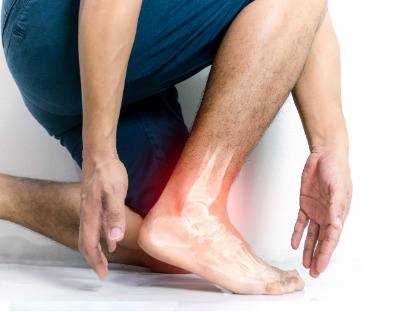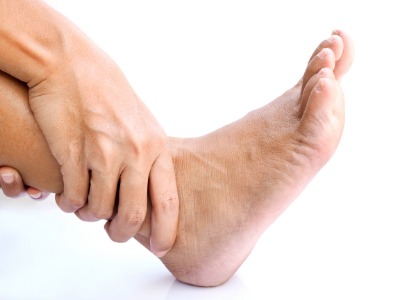Calf Pain After Knee Replacement
Calf and thigh pain is common after a total knee replacement. Calf pain may be caused by sore muscles due to increased swelling, altered walking mechanics, limited range of motion, and performing new exercises like ankle pumps and heel slides.
Tight Calf Muscles After a Knee Replacement May be Caused by New Alignment
After a total knee replacement, your new knee changes the alignment of the hip and ankle.
Many clients have some form of bowing in their leg before surgery.
Genu Varum also known as bow-legged is when the knee curves outward.
Genu Valgum also known as knock-kneed is when the knee curves inward.
Prior to surgery, your body has adapted to these mechanical changes over many years of your life. Now your new knee has changed decades of malalignment in 30-minutes. It is normal for your body to several weeks or months to adapt.
* Recommendation: Talk to your physical therapist to learn which exercises you can do to normalize your alignment and improve hip and ankle mobility in the process.
Calf and Ankle Pain After A Knee Replacement
Since a new knee changes the alignment of the whole leg it is common to experience ankle and calf pain during your recovery.
If the knee curved inward before surgery ‘Genu Valgum’ then the new, straight knee will increase medical ankle compression and may cause pain on the inside of the ankle.
* Recommendation: Your physical therapist may prescribe several exercises that increase ankle ‘eversion’ to improve the mobility of the inside ankle.
Conversely, if the knee curved out ‘Genu Varum’ before surgery then pain at the outside of the ankle may be more commonly experienced after surgery.
* Recommendation: Your physical therapist may prescribe several exercises that increase ankle ‘inversion’ to improve the mobility of the outside ankle.
These are normal symptoms and should improve in a few weeks of walking and joint specific exercises.

Why is my calf so tight after knee replacement surgery?
Swelling – as the edema or swelling starts to accumulate in the lower leg that fluid is pushing in as much as it pushes out.
Imagine someone squeezing your muscles 24-hours a day, 7-days a week. That would start to become painful.
Since you are not walking and moving as much as you normally would your swelling does not have the ability to move out of the lower leg and back into the system.
* Recommendations: Some therapists will perform compression wrapping to move the fluid out of the lower leg. You may have also been told to elevate your leg to reduce swelling. Finally, as you become more mobile and start walking more the act of walking will help squeeze some of the fluid out of your ankle and calf.
Below is Amazon’s “Best Overall Massage Gun” Pick for 2021
What can I do to reduce the calf pain?
To reduce calf pain and lower leg swelling you should schedule a time to stand and walk every one to two hours during your first two weeks after surgery.
You may also have been prescribed compression stockings by your surgeon or physical therapist. You should use these as prescribed.
You may try some form of self-massage. Here is a video of a rolling pin massage that is commonly recommended after knee replacement.
Tight Calf Muscles After Surgery
Stretching can be an effective strategy to reduce calf muscle tightness. These wedges are sold on Amazon as tire chocks and are incredibly effective for stretching a calf muscle.
Stretching may be performed after a rolling pin massage for better results. The massage will help warm up the muscle and promote fluid exchange. Then the stretch will help lengthen the muscle.
Shin and Ankle Pain
Sometimes clients will experience shin and ankle pain after knee replacement surgery. This too is usually caused by the new alignment of the knee as well as increased activity levels.
Before surgery, many clients were unable to walk and exercise due to pain. After surgery and during physical therapy many clients are doing far more than they are accustomed to doing. This increase in activity may account for shin pain in the bone or muscles alongside the bone.
Another common report is pain and the front of the ankle. This may be due to tightness between the tibia and fibula (which are the bones of the lower leg.)
Massages and stretching of these areas can be a great way to alleviate this pain.

Calf Pain May Persist for Several Weeks or Months After A Knee Replacement
Since there are so many possible causes of pain in the calf and ankle, it is impossible to determine how long the associated pain will last.
For most clients, their symptoms will resolve in the first 6 to 12 weeks. If pain persists beyond that timeframe without a known cause it is recommended that you consult with your surgical team and physical therapist for further medical assessment.
To See Video 1 Look Below:
Pinching Behind Your Knee After Total Knee Replacement
A common report I get from clients who are struggling to improve knee flexion is that they are feeling a pinch in the back of their knee as they try to bend it. This pinching in the back of your could may be caused by the implant pinching the soft tissue or a baker's...
What to Expect the First Week After your Knee Replacement Surgery
Week 1 After Knee Replacement Surgery If your surgery was performed in an outpatient surgery center then you would have likely been discharged to your home the day of surgery. In this article I will be discussing what you need during the first week after total knee...
How to Choose the Best Physical Therapist
There are many factors that go into choosing the best physical therapist for your rehabilitation. One such factor is access. If you are having a total knee replacement you will inevitably have questions about your incision or positioning or any number of other...
9 BEST Gift Ideas for Anyone Having A Total Knee Replacement in 2022
This article includes my favorite list of the 9 Best Gift Ideas for Anyone Having a Total Knee Replacement in 2022. Cyotherapy Moist heat Walker tray/basket Ankle & Calf Massager Rolling Pin Water Bottle Journal Audio Book Membership Meal Delivery Cryotherapy...
Tight Calf Muscle After Knee Replacement
Calf pain after a total knee replacement or other knee surgery if very common. Part of the problem is the swelling, part is weakness in the muscle and part is the dramatic change in activity level.
In this video I explain these three causes of calf pain as well as some solutions we usually recommend in the clinic. After watching this video I will share recommended exercises you can ask your therapist about.
Baker’s Cyst After Knee Replacement
A Baker's cyst resolved in only a small number of patients (15%) one year after TKA and symptoms from the cysts persisted in 31%. Cite this article: Bone Joint J 2016;98-B:1185-8.[1]What is a Baker's Cyst?If you have ever felt that painful swollen lump behind your...

